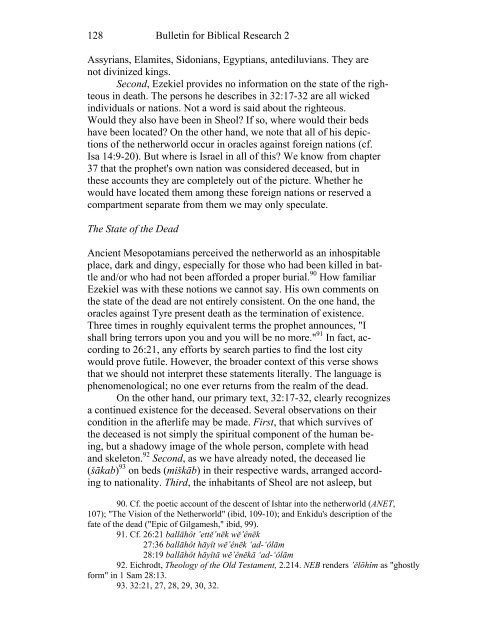Beyond the Grave - Institute for Biblical Research
Beyond the Grave - Institute for Biblical Research
Beyond the Grave - Institute for Biblical Research
Create successful ePaper yourself
Turn your PDF publications into a flip-book with our unique Google optimized e-Paper software.
128 Bulletin <strong>for</strong> <strong>Biblical</strong> <strong>Research</strong> 2<br />
Assyrians, Elamites, Sidonians, Egyptians, antediluvians. They are<br />
not divinized kings.<br />
Second, Ezekiel provides no in<strong>for</strong>mation on <strong>the</strong> state of <strong>the</strong> righ-<br />
teous in death. The persons he describes in 32:17-32 are all wicked<br />
individuals or nations. Not a word is said about <strong>the</strong> righteous.<br />
Would <strong>the</strong>y also have been in Sheol? If so, where would <strong>the</strong>ir beds<br />
have been located? On <strong>the</strong> o<strong>the</strong>r hand, we note that all of his depic-<br />
tions of <strong>the</strong> ne<strong>the</strong>rworld occur in oracles against <strong>for</strong>eign nations (cf.<br />
Isa 14:9-20). But where is Israel in all of this? We know from chapter<br />
37 that <strong>the</strong> prophet's own nation was considered deceased, but in<br />
<strong>the</strong>se accounts <strong>the</strong>y are completely out of <strong>the</strong> picture. Whe<strong>the</strong>r he<br />
would have located <strong>the</strong>m among <strong>the</strong>se <strong>for</strong>eign nations or reserved a<br />
compartment separate from <strong>the</strong>m we may only speculate.<br />
The State of <strong>the</strong> Dead<br />
Ancient Mesopotamians perceived <strong>the</strong> ne<strong>the</strong>rworld as an inhospitable<br />
place, dark and dingy, especially <strong>for</strong> those who had been killed in bat-<br />
tle and/or who had not been af<strong>for</strong>ded a proper burial. 90 How familiar<br />
Ezekiel was with <strong>the</strong>se notions we cannot say. His own comments on<br />
<strong>the</strong> state of <strong>the</strong> dead are not entirely consistent. On <strong>the</strong> one hand, <strong>the</strong><br />
oracles against Tyre present death as <strong>the</strong> termination of existence.<br />
Three times in roughly equivalent terms <strong>the</strong> prophet announces, "I<br />
shall bring terrors upon you and you will be no more." 91 In fact, ac-<br />
cording to 26:21, any ef<strong>for</strong>ts by search parties to find <strong>the</strong> lost city<br />
would prove futile. However, <strong>the</strong> broader context of this verse shows<br />
that we should not interpret <strong>the</strong>se statements literally. The language is<br />
phenomenological; no one ever returns from <strong>the</strong> realm of <strong>the</strong> dead.<br />
On <strong>the</strong> o<strong>the</strong>r hand, our primary text, 32:17-32, clearly recognizes<br />
a continued existence <strong>for</strong> <strong>the</strong> deceased. Several observations on <strong>the</strong>ir<br />
condition in <strong>the</strong> afterlife may be made. First, that which survives of<br />
<strong>the</strong> deceased is not simply <strong>the</strong> spiritual component of <strong>the</strong> human be-<br />
ing, but a shadowy image of <strong>the</strong> whole person, complete with head<br />
and skeleton. 92 Second, as we have already noted, <strong>the</strong> deceased lie<br />
(šākab) 93 on beds (miškāb) in <strong>the</strong>ir respective wards, arranged accord-<br />
ing to nationality. Third, <strong>the</strong> inhabitants of Sheol are not asleep, but<br />
90. Cf. <strong>the</strong> poetic account of <strong>the</strong> descent of Ishtar into <strong>the</strong> ne<strong>the</strong>rworld (ANET,<br />
107); "The Vision of <strong>the</strong> Ne<strong>the</strong>rworld" (ibid, 109-10); and Enkidu's description of <strong>the</strong><br />
fate of <strong>the</strong> dead ("Epic of Gilgamesh," ibid, 99).<br />
91. Cf. 26:21 ballāhôt ’ettĕ’nēk wĕ’ênēk<br />
27:36 ballāhôt hāyît wĕ’ênēk ‘ad-‘ôlām<br />
28:19 ballāhôt hāyîtā wĕ’ênĕkā ‘ad-‘ôlām<br />
92. Eichrodt, Theology of <strong>the</strong> Old Testament, 2.214. NEB renders ’ĕlōhîm as "ghostly<br />
<strong>for</strong>m" in 1 Sam 28:13.<br />
93. 32:21, 27, 28, 29, 30, 32.

















